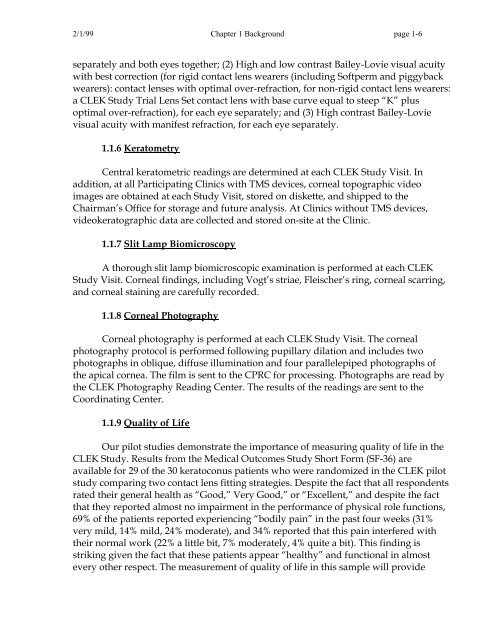OM t of c.iii - Vision Research Coordinating Center - Washington ...
OM t of c.iii - Vision Research Coordinating Center - Washington ...
OM t of c.iii - Vision Research Coordinating Center - Washington ...
You also want an ePaper? Increase the reach of your titles
YUMPU automatically turns print PDFs into web optimized ePapers that Google loves.
2/1/99 Chapter 1 Background page 1-6<br />
separately and both eyes together; (2) High and low contrast Bailey-Lovie visual acuity<br />
with best correction (for rigid contact lens wearers (including S<strong>of</strong>tperm and piggyback<br />
wearers): contact lenses with optimal over-refraction, for non-rigid contact lens wearers:<br />
a CLEK Study Trial Lens Set contact lens with base curve equal to steep “K” plus<br />
optimal over-refraction), for each eye separately; and (3) High contrast Bailey-Lovie<br />
visual acuity with manifest refraction, for each eye separately.<br />
1.1.6 Keratometry<br />
Central keratometric readings are determined at each CLEK Study Visit. In<br />
addition, at all Participating Clinics with TMS devices, corneal topographic video<br />
images are obtained at each Study Visit, stored on diskette, and shipped to the<br />
Chairman’s Office for storage and future analysis. At Clinics without TMS devices,<br />
videokeratographic data are collected and stored on-site at the Clinic.<br />
1.1.7 Slit Lamp Biomicroscopy<br />
A thorough slit lamp biomicroscopic examination is performed at each CLEK<br />
Study Visit. Corneal findings, including Vogt’s striae, Fleischer’s ring, corneal scarring,<br />
and corneal staining are carefully recorded.<br />
1.1.8 Corneal Photography<br />
Corneal photography is performed at each CLEK Study Visit. The corneal<br />
photography protocol is performed following pupillary dilation and includes two<br />
photographs in oblique, diffuse illumination and four parallelepiped photographs <strong>of</strong><br />
the apical cornea. The film is sent to the CPRC for processing. Photographs are read by<br />
the CLEK Photography Reading <strong>Center</strong>. The results <strong>of</strong> the readings are sent to the<br />
<strong>Coordinating</strong> <strong>Center</strong>.<br />
1.1.9 Quality <strong>of</strong> Life<br />
Our pilot studies demonstrate the importance <strong>of</strong> measuring quality <strong>of</strong> life in the<br />
CLEK Study. Results from the Medical Outcomes Study Short Form (SF-36) are<br />
available for 29 <strong>of</strong> the 30 keratoconus patients who were randomized in the CLEK pilot<br />
study comparing two contact lens fitting strategies. Despite the fact that all respondents<br />
rated their general health as “Good,” Very Good,” or “Excellent,” and despite the fact<br />
that they reported almost no impairment in the performance <strong>of</strong> physical role functions,<br />
69% <strong>of</strong> the patients reported experiencing “bodily pain” in the past four weeks (31%<br />
very mild, 14% mild, 24% moderate), and 34% reported that this pain interfered with<br />
their normal work (22% a little bit, 7% moderately, 4% quite a bit). This finding is<br />
striking given the fact that these patients appear “healthy” and functional in almost<br />
every other respect. The measurement <strong>of</strong> quality <strong>of</strong> life in this sample will provide
















